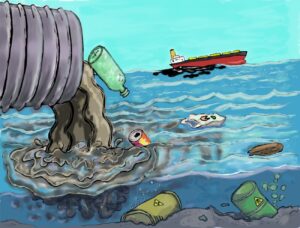Rocket fuel (Perchlorate) is in the news…again.
Testing showed that “fast food and fresh produce had the highest levels, while beverages, seafood and meats had the lowest.”
However, rocket fuel contamination has been well known for decades as a contaminant, widespread in the water supply. How does rocket fuel get into the food and water?
Most drinking water contamination comes from activities related to the manufacture, disposal, and research of propellants, explosives, and pyrotechnics, as well as to accidental releases from manufacturing facilities and rocket launch failures, according to the National Institutes of Health’s Agency for Toxic Substances and Disease Registry. There are other sources of contamination, too, according to the ATSDR, including fireworks, road safety flares, and certain fertilizers. When crops are irrigated with contaminated water, that leads to contaminated produce.
 The scientific way around any toxin is to normalize and naturalize it. The U.S. Environmental Protection Agency (EPA) states, Perchlorate may occur naturally, particularly in arid regions such as the southwestern United States.
The scientific way around any toxin is to normalize and naturalize it. The U.S. Environmental Protection Agency (EPA) states, Perchlorate may occur naturally, particularly in arid regions such as the southwestern United States.
Perchlorate is anything but natural.
As a known goitrogen, Perchlorate prevents the uptake of iodine to affect the thyroid. Along with chloride and fluoride, added to public water supplies, as well as lead, PCBs, pesticides, nitrates, formaldehyde, and other toxins, Perchlorate is only one reason for a global epidemic of thyroid disease.
Thus, Perchlorate is not the only toxin in the water.
In 2016, toxic water made headlines when the EPA announced that water was unsafe to drink in Flint, Michigan due to lead contamination. But water dangers in Flint go back to 2003. By 2017, the consequences of drinking toxic water turned up as an increase in fetal deaths and a drop in fertility rates. In 2024, the EPA says lead in Flint water is at acceptable levels.
…financial motives are causing government science agencies to ignore inconvenient truths—like high levels of lead in public drinking water. – Marc Edwards, the Virginia Tech civil engineering professor who helped expose the Flint water crisis, February 4, 2016

Instead of reassuring residents of Michigan, that lead could be filtered from the water using carbon filters, the government supplied bottled water – one bottle per day per resident – bottles which carry their own toxins of nanoplastics.
The researchers found that, on average, a liter of bottled water included about 240,000 tiny pieces of plastic. About 90% of these plastic fragments were nanoplastics. – NIH, January 2024
Ironically, most bottled water in the U.S. is tap water.
In 2018, Mark Edwards, the Virginia Tech researcher who helped expose the 2016 Flint, Michigan water crisis, was barred from testing well water in South Carolinia.
Not Safe To Drink
Agencies, such as the Department of Natural Resources, and the EPA claim public water supplies are safe to drink. Some of the reported water-related disasters over the last decade show otherwise:
- Fluoridation of water using waste byproducts (hydrofluorsilicic acid) from the phosphate fertilizer industry.
- August 2015 Gold Mine disaster in Colorado that sent 3 million gallons of contaminated wastewater (lead, arsenic, mercury, cadmium, uranium, cyanide, sulfuric acid, etc.) into rivers that supply drinking water to at least three states (Colorado, New Mexico and Utah) as well as the Navajo Nation. The spill resulted from a blow-out, a risk that EPA knew about, but are washing their hands of any responsibility.
- November 2015 Mining disaster in Brazil, from the Samarco mine in an area where around 150,000 people are still reliant on deliveries of drinking water. “The best thing that can happen now is for the mud to flow out to sea as quickly as possible,” said Antonio de Padua Almeida, a biologist and head of the local Comboios nature reserve. “The mud will have much greater impact on the river than on the sea.”
 Discovery of PFOA’s (Perfluorooctanoic acid, also known as C8), chemicals from Dupont’s Teflon manufacturing process, that are now pervasive around the world though water systems. “DuPont pumped hundreds of thousands of pounds of PFOA powder through the outfall pipes of the Parkersburg facility into the Ohio River.
Discovery of PFOA’s (Perfluorooctanoic acid, also known as C8), chemicals from Dupont’s Teflon manufacturing process, that are now pervasive around the world though water systems. “DuPont pumped hundreds of thousands of pounds of PFOA powder through the outfall pipes of the Parkersburg facility into the Ohio River. - One million tons of oil enters the marine environment annually. The 2010 BP Oil disaster in the Gulf —and the addition of the toxic chemical Corexit has longterm human and environmental effects.
- Fracking water being used to irrigate organic crops, such as fruits and vegetables in numerous states like Texas and California.
- Flint, Michigan water crisis, 2016 (lead)
- Ohio 2023 train derailment spills hazardous chemicals. As of October 2023, 742 incident reports for train derailments in the U.S. have been recorded. [See derailment and spills map of U.S.].
- Graphene oxide and hydrogels (nanotechnology) used in vaccines, wastewater treatment, and water filtration, is also spread via cloud seeding and climate engineering.
Various synthetic medications, hormones, anti-depressants, and nanotechnologies make their way to public water that cannot be filtered out. Chemicals, such as Triclosan used in hand sanitizers, creates chloroform when mixed with tap water. Triclosan is an antimicrobial chemical, also known to affect thyroid function.
Nitrates in ground water from pesticide run-off, fertilizers, and septic tank waste affect fertility. [See evidence of nitrates in drinking water by state].
Focus on age-old contaminants distracts from new threats at a nano-level.
How do we control an unseen threat?
Nanotech Toxicity
 What is a nanoform? How would EPA regulate it?
What is a nanoform? How would EPA regulate it?
Current regulations do not adequately address the development and use of nanomaterials in any system, human or otherwise.
A nanometer is roughly 10,000 times smaller than the diameter of a human hair and 1 million times smaller than a single grain of sand. A major concern with new technologies are unknown risk factors.
First, due to their extremely small size, nanoparticles are difficult to contain, meaning they could escape into the environment and pose a threat to aquatic life, all life. Secondly, the enhanced reactivity of nanoparticles increases their toxicity.
As we inject a nanomaterial into groundwater to remediate a problem are we simultaneously creating a new problem by injecting a material that may have adverse environmental effects? – Troy Benn, ASU researcher in environmental engineering
Graphene oxide, as an electrically-charged magnetic nanoform, is considered relatively ‘new.’ Even the structure of graphene oxide, as a one atom thick layer of carbon atoms, is still unclear due to its complicated non-stoichiometric nature.
There are never any regulations published before new technologies are unleashed into the environment (eg. GMO crops and mosquitoes). Yet, graphene is now used in all industries, from plastics, and water filtration, to dental anesthetics, biomedical applications and cloud seeding.
Impacts and Solutions

A little known fact is that water holds memory. Humans are 99% water at the molecular level.
What does nano-contamination do to the collective memory of humanity? We know Alzheimer’s is a disease of Aluminum toxicity.
The problems are multifaceted: 1) the failure of government scientists, and agencies, to acknowledge a problem, 2) failure of agencies to do their job to protect the public health, 3) the failure of people to question the status quo.
The impacts are many, from reproductive harm to shortened lifespan, to the destruction of habitats, and oxygen depletion. Unfortunately, mitigation solutions are far behind the rollout of contamination.
Basic Solutions to Complex Problems
- Test your well water or water source.
- Find and collect a clean source of water, or boil and filter tap water (avoiding nanofiltration)
- Stop eating processed foods; know your farmer, and grow your own.
- Reduce your plastic consumption and reuse or recycle plastic when you can.
- Don’t drink bottled water.
- Don’t flush old medications.
- Opt for herbs and homeopathy over synthetic medications.
- Properly dispose of chemical cleaners, oils, and nonbiodegradable items to keep them from going down the drain.
While individual solutions are a mere drop in the industrial toxic waste bucket, they can protect your health where you live. Simply take responsibility for what you inhale, ingest, imbibe, and inject.
Related Articles:







Good work, consistently!
I hope you keep it on.
Many thanks, Bevan. Glad you’re here.